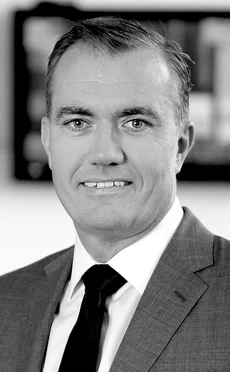
A sea change – Driving awareness to confront climate risk

Amid a global push towards green policies, the reality of overhauling how industries worth trillions of dollars operate is causing concern. A forum of market participants and sponsors of this report discuss the levels of awareness of climate risk and its prevention at all levels, whether current regulatory targets are achievable and where the responsibility lies for gauging climate risk
The panel
- Nazim Osmancik, Chief Risk Officer, Energy Marketing & Trading, Centrica
- Maryam Golnaraghi, Executive and Leading International Expert, Director of Climate Change and Emerging Environmental Topics, The Geneva Association
- Soledad Díaz-Noriega, Partner, Management Solutions
- Marion de Marcillac, Executive Director, ESG Products, MSCI
- Morgan Després, Head of Secretariat, Network for Greening the Financial System, and Deputy Head, Financial Stability Department, Banque de France
- Peter Plochan, Principal Risk Management Advisor, SAS
- Naeem Siddiqi, Senior Advisor, Risk and Quantitative Solutions, SAS
- Kevin McGeeney, Chief Executive, SCB
- Adityadeb Mukherjee, Head of Climate Risk Management, Standard Chartered
- Aiman El-Ramly, Chief Business Officer, ZE PowerGroup
To what extent are financial and energy firms still in denial about climate change?

Soledad Díaz-Noriega, Management Solutions: Bearing in mind that the answer varies depending on geography, in general terms we observe that firms are at one of three stages:
1. Those fully aware of climate risk, who have been developing their climate risk management framework for several years already.
2. Those who have recently become aware that climate change will have a relevant impact on their future, and who are taking tentative but solid steps to manage it.
3. Finally, those who still address the phenomenon of climate change only from a reputational perspective.
In the latter case, social pressure, investors and – in certain regions, such as Europe – emerging regulation will push these firms to transform either by conviction or by obligation.
Aiman El-Ramly, ZE PowerGroup: I don’t believe they are in denial about climate change at all. More so, I believe they are realists when it comes to understanding the economic dependency on energy and the technical difficulties in moving to a non-fossil environment. While regulation can provide punitive means to pursue desired changes in fossil dependency, substantive technical advancement in storage and grid management is necessary. Moreover, a mismatch in global climate policy and initiatives means that isolated activities are less impactful and create economic disadvantages.
Marion de Marcillac, MSCI: Until now, measuring the potential impact of transitional or physical risks, or the economic impact of climate change, on portfolios was limited owing to the lack of tools available to investors. If firms don’t have accurate information on which to act, they cannot effectively price climate-related risks and opportunities, and may risk systematically misallocating capital.
To date, regulation has focused on the assessment of current, short-term risk exposure rather than forward-looking assessments as recommended by the Task Force on Climate-related Financial Disclosures (TCFD). Fund managers and financial analysts generally have horizons that do not extend beyond the next five years and, as a result, corporate reporting rarely includes forward-looking disclosure beyond that timeframe. In 2020, only 11% of MSCI All Country World Index – now known as MSCI ACWI – constituents disclosed all TCFD-recommended information regarding their carbon emissions reduction targets. Of the remaining firms, 54% had not disclosed any carbon emissions targets and 35% had disclosed targets without further specifying the base year, targeted reduction per annum or target year.1
Kevin McGeeney, SCB: We should bundle climate change deniers with those who draw up short of doing enough. Inaction ends up in the same place as denial. More broadly, equating denial and inaction, financial and energy firms are nowhere near where they need to be on climate change. However, if expressing concern was enough, the financial and energy industries could be regarded as fully prepared for climate change.
Adityadeb Mukherjee, Standard Chartered: We do not believe most financial and energy firms are in denial about climate change – although, understandably, the speed and intensity with which firms are responding to the challenge varies greatly. Standard Chartered has long recognised climate change as the biggest existential threat of our times, and has taken bold actions – for example, from initially committing to not funding any new coal-fired power plants, to more recent ambitious targets around clients dependent on thermal coal, and significantly increased targets around renewables. Thematic scrutiny from regulators, investors, clients, non-governmental organisations and other stakeholders on this topic is ever-increasing, and the science is quite clear – so denial is not really an option. However, challenges remain in future projections and the uncertainty around timings and impact in the short term, which is hindering globally co‑ordinated action on climate change, and impacting the pace of integration of climate change into all business decisions. Standard Chartered believes working together with a wide spectrum of stakeholders is the way to overcome this.
Naeem Siddiqi, SAS: There’s increasing awareness among financial firms at the board level, but it hasn’t always filtered down to lower levels such as the modelling teams. At the top there’s effort to recognise climate risk exposures and pre-empt impending regulations requiring disclosures. That will vary by region, but the likes of BlackRock, the European Construction Bank and Societe Generale announcing intentions to scrutinise companies deeper on disclosure and reduce exposure to coal industries and other fossil fuels may help banks accelerate their disclosure regimes sooner.
We’ve seen a shift in awareness among financial companies since the Network for Greening the Financial System (NGFS) – the global association of 60-plus regulators and central banks – last year documented its commitment to managing climate risk.
In places such as Canada, the oil industry dominates the economy in certain regions, so local banks are pursuing policies to be green – but at the same time it’s unrealistic to walk away from hundreds of billions of dollars of business. This is a complex and nuanced issue where government policies and regional politics all come into play. The transition is much easier for smaller European countries to move away from fossil fuels because there is less money at stake.
Banks have been active in the environmental, social and corporate governance (ESG) and sustainability spaces, but this was often more about trying to look good – about marketing and reputation.
Morgan Després, NGFS and Banque de France: From an NGFS perspective, the mispricing of climate risk is at stake. For a number of reasons, climate risks are currently not appropriately priced by market participants. There is a lack of disclosure and forward-looking approach to measuring exposures. In general, firms may be reluctant to adopt a longer-term perspective and they don’t necessarily want to voluntarily expose their material risks to climate change. It’s our job as supervisors and central banks to find the right metrics and methodologies to provide more clarity on exposures, and reach a better allocation of capital, more in line with climate objectives.
Maryam Golnaraghi, The Geneva Association: I don’t believe companies are, in general, in denial about the scientific evidence behind climate change – nor the need for transitioning to a resilient low-carbon economy. However, there are shortcomings regarding the urgency and speed with which they are approaching the transition. This could be addressed through a clear public policy signal and related incentives from government to the private sector.
The Paris Agreement on climate change requires all parties to put forward their best efforts through nationally determined contributions (NDCs) and to strengthen these efforts in the years ahead. While governments have shared their NDCs, not all are aligned with Paris Agreement targets. This may be a generalisation but, in every sector, around 5–15% of the largest firms – althought this percentage is typically higher in the financial and insurance sectors than in carbon-intensive sectors – have initiated their systematic integration of climate risk and opportunity into their core business.
This means climate change has been raised to a strategic topic linked to core business for boards and C‑suites, with individual accountability. These firms are adopting the recommendations of the Financial Stability Board’s TCFD – not just for the sake of disclosure and reporting but as a way of mobilising and engaging their companies in the process of assessing risks and opportunities to drive climate change strategy and policy for the corporation. These companies are actively investing in tools, data and expertise to build their climate risk analytics capacities, working with regulators to shape future regulations and investing in a variety of technologies and innovations in their core business.
For many others, boards and C-suites want to develop a climate strategy and implement it, whether as an integral part of their overall sustainability programme or not. The key issue is they need help with how to do it.
Those that remain in denial will have difficulties turning their companies around if they have not planned for transition to low-carbon business models.
To help businesses align more quickly with the Paris Agreement, a number of actions are needed.
Governments must establish clear and aligned sectoral public policy, supported by effective legislative and regulatory frameworks to enable a planned transition phase. Conflicting government subsidies send inconsistent signals to the market. To this end, government consultations with industry leaders, financial and insurance sector and technology firms would be essential in defining viable transition paths.
At the same time, credit rating agencies could step up their efforts to factor climate change into corporate ratings, influencing consumer preferences and raising demand for low-carbon products and market conditions.
Investors and shareholders should be actively engaged in support of company transitions. Business leaders also need to take a more proactive role in steering their firms strategically and effectively through the change process. This would require board-level directors and C-suites to assess risks and opportunities and develop a transition plan, engaging all divisions and departments. They must build their expertise in this area, and consider climate change a part of their core decisions, from corporate governance and strategy to enterprise risk management and the entire supply chain. They will need to invest in climate risk analytics and expertise, integrate climate risk assessment and management in all aspects of their business decisions, and break through their institutional silos and cultural barriers to develop more integrated and holistic solutions.
These firms must engage with their insurers to identify innovative solutions for protecting their assets, enabling and financing the transition to new business models. Access to a strong, vetted ecosystem of data and analytics, management and strategy consulting, insurance, financial and legal support services could help corporations with their transformation.
Nazim Osmancik, Centrica: I cannot speak for the entire industry, but I believe that most firms have recognised climate change and are actively doing something about it. Centrica embedded enabling the transitioning of customers and energy systems to a lower-carbon future as an official business ambition with clear metrics to measure progress.
How realistic is the Paris Agreement on climate change’s target of keeping global warming to “well below” 2º Celsius above pre‑industrial levels?

Marion de Marcillac: In a report published in October 2018, the Intergovernmental Panel on Climate Change (IPCC) projected an increase from the present 1°C above pre-industrial levels to 1.5°C of average warming between 2030 and 2052 if warming continues at its current rate. Warming of 1.5°C will already pose unprecedented but potentially manageable climatic challenges to ecosystems and societies. Even if the Paris Agreement is implemented as envisioned and its objectives fully realised, the frequency and severity of extreme weather will continue to increase, and chronic, slow-onset manifestations of physical climate change – such as sea-level rise or temperature increase – will continue to unfold.2
MSCI has developed a ‘warming potential’ metric, which is expressed as a temperature, to help investors understand how their portfolios align with the Paris Agreement target of 1.5°C. Warming potential is calculated by combining top‑down data derived from the Paris Agreement, and bottom‑up economic, sector and company data to establish a forward-looking set of climate-related metrics. We also apply the metric to 10,000 companies.
Nazim Osmancik: It will be possible, but very challenging, to meet the Paris Agreement’s targets. Major changes to the existing energy supply mix, transport infrastructure and building stock will be required while serving growing demand for energy, especially in the developing world. But, the difficulty around meeting the Paris Agreement targets does not mean we should not try as hard as we can, and we have recently seen strong momentum in terms of action taken by governments and the private sector. Centrica is taking on the challenge on three different fronts:
1. By helping customers reduce their emissions via the services and solutions we provide
2. By offering flexible, distributed and low-carbon technologies
3. By reducing its own emissions in line with the Paris Agreement.
Kevin McGeeney: It is not credible to believe the Paris Agreement goals of 1.5ºC or even 2ºC can be attained solely through government compulsion on reluctantly co‑operative companies. The pace of industrial change through compelled actions is too slow. For example, a gallon of road transport fuels has been decarbonised by 7% over 15 years of forceful programmes in the US and European Union. That is an example of slowness and a lack of ambition from the top. However, to achieve even that goal, the people working in the space did so diligently and enthusiastically.
Maryam Golnaraghi: The past 40 years have seen unprecedented partnerships established in the scientific community to enable co‑ordinated research – of which there have been 25 years of international climate change framework negotiations. There has been a global effort to mobilise capital and activate financial markets to fund the transition to a net-zero economy, motivated by the TCFD and the emergence of the sustainable finance frameworks. But we are still far from reaching the objectives of the
Paris Agreement.
Responses to climate change are still more in the form of talk and generating headlines than action. Deeply fragmented initiatives and silos persist across many institutional stakeholders. Reaching the goals of the Paris Agreement will require evolving away from the siloed public policies of the 20th century, and reimagining our institutional structures, consumption behaviours and socioeconomic values.
Defining net-zero solutions and feasible pathways to transition will only be possible through unprecedented alliances across all levels of government, the insurance and financial industries and the fields of science and technology.
Aiman El-Ramly: It is unrealistic in the current policy-heavy and innovation-light business and regulatory environments. Population growth and deforestation alone make those objectives near impossible. In the absence of major shifts in global consumption behaviour, it will not happen.
Peter Plochan, SAS: Very few people can estimate this, which creates lot of uncertainty – that’s the problem banks face. The objective of the Paris Agreement is very ambitious and the currently submitted action plans from countries are still not sufficient, with their forecasted impact resulting in a temperature increase more in the range of 3ºC. With stress-testing, banking regulators and banks are considering a few alternative scenarios – for example, below 2º, 2.5º and 3ºC warming – and are trying to assess the portfolio impact of each. This is very hard to estimate because of the uncertainties around actions taken to fight climate change, their effectiveness and the resulting impacts on the economy and banking portfolios. A speaker at a global risk conference I attended recently said, at 3ºC warming, the world becomes uninsurable, so let’s hope we don’t get there.
This is a global problem, so coming up with a plan that everyone can stick to is probably more important than drawing a line in the sand that’s not realistic.
Adityadeb Mukherjee: Current projections and academic research suggest it will be quite challenging to meet the target set out by the Paris Agreement unless urgent action is taken over the next 10 years. The concentration of greenhouse gas and carbon in the atmosphere has reached unprecedented levels. Furthermore, there would be a lag between any potential reduction of carbon concentration and a resulting reduction in warming levels. Standard Chartered’s Opportunity2030 report reiterates the scale of investment required between 2020 and 2030 to drive the climate action necessary to achieve the Paris Agreement target.
Morgan Després: It is probably still feasible, but there is always a trade-off involved. If you take a realistic look at the political situation and how things progressed at the UN Climate Change Conference of the Parties (COP) in Madrid last year, you may question the willingness of governments to take action. That’s probably why – with the UK presiding over this year’s COP 26 – much is expected from other stakeholders, such as the private sector and central banks, for governments to bring in more ambitious targets.
To what extent have firms been able to take advantage of new technology and analytics in this area?

Maryam Golnaraghi: Driven by the TCFD and sustainable/green finance initiatives in jurisdictions such as the EU, the UK, France, Australia and Canada, there are a number of developments worth highlighting.
On the demand side, the degree of adoption by companies differs by jurisdiction, sector, line of business and size. In Europe, for example, the greatest take-up has been among banks, asset managers and insurers, compared with corporations in carbon-emitting economic sectors such as energy, transportation and agriculture. In Japan, however, more corporations have been adopting TCFD and reporting than the financial sector.
The main needs – in terms of technology and analytics – are data, standard tools and methodologies and expertise in modelling, interpreting and using climate risk analysis in all aspects of decision-making. Some companies are investing in new climate risk analysis tools and exploring cutting-edge climate and weather data and forecasting technologies.
In addition, companies such as large (re)insurers and Fortune 100 firms with complex supply chains are considering digitisation, big data, cloud platforms cloud computing, the internet of things and artificial intelligence (AI) for system-wide predictive risk analysis, responsive management and predictive maintenance of their assets. To this end, some are also deploying advanced control systems and sensors, satellites and drones as part of system-wide monitoring for optimisation, and anticipation of system failures from recurrent weather extremes, for example.
On the supply side, a complex landscape of physical and transition climate risk modelling providers is emerging, deeply fragmented in terms of type of risk, underpinning methodologies, target sectors and other factors.
The UN Environment Programme Finance Initiative and insurance industry platforms The Geneva Association and ClimateWise are urging banks, asset managers, insurers and climate experts to review, assess and collectively develop approaches to integrating physical and transition risk in financial decisions and core insurance business.
A range of sustainability, accounting and management consulting firms are offering services to corporations to assess their climate risks under different scenarios such as those set by the International Energy Agency and IPCC.
Simultaneously, catastrophe risk modelling firms are increasingly considering how to incorporate forward-looking climate data. More than 30 environmental financial technology – known as fintech – firms and climate risk data start-ups have emerged in recent years, offering a wide range of tools and methodologies, from rudimentary big data analytics to sophisticated climate risk modelling and assessments.
The insurance industry is pooling resources and expertise through The Geneva Association to explore and develop the next generation of climate risk models with forward-looking climate information. Through cross-sectoral mobilisation, the aim is to develop a road map for advancing and augmenting physical and transition climate risk modelling, linked to both sides of the balance sheet. Bridging the latest science and technologies with financial and core business decisions will be central to future initiatives.
What role should regulatory stress-testing play in helping the financial industry assess climate risk?

Peter Plochan: The approach that would work for climate change would have to be similar to Basel II or III – providing a set of international principles and a level playing field. For any regulatory actions such as capital allocation and disclosures, the TCFD and NGFS are key. The regulators need to agree on a standard approach globally for it to be successfully adopted by international banks.
Regulations are currently a patchwork worldwide. Some countries have plans for mandatory TCFD disclosures while, in other jurisdictions, regulators are leaning towards voluntary disclosure. This disparity will continue until some sort of international agreement is established. In the meantime, initiatives of large institutional investors such as the Investor Agenda or Climate Action 100+ are leading the way by promoting low-carbon investments globally and spurring firms to disclose their climate change exposures. Another prompt may come from consumers boycotting the worst‑offending companies and the banks that finance them.
It is also likely regulators will impose some sort of capital charge for ‘brown’ assets. Climate change is now becoming a financial risk management topic. Regulators are convinced there’s increased credit risk from certain types of assets that are more exposed to climate change than the others. Banks need to recognise this as a long-term issue and plan for it, whether it’s increased allowance for losses or changes to lending and investment policies, capital, stress-testing or any other area of a bank’s operations.
Adityadeb Mukherjee: Stress-testing – and, more broadly, scenario analysis – is critical to the assessment of climate risks, perhaps even more than conventional financial risks. The long-term nature of climate risks and uncertainties in future policy, technology and consumer preferences make scenario analysis imperative in climate risk management.
Morgan Després: Within the NGFS and Banque de France, the focus is on scenario analysis. If you look at exposures using, for example, the TCFD measures, you’ll have a view at a given time, but it will give you limited insights on the dynamics of your exposures over the longer term. We need to marry the climate scenarios with financial data, developing a dynamic analytical approach using scenarios as a complement to the classic snapshot of exposures. It’s a key objective for the NGFS, and we’re due to release some detailed scenarios by the end of this year.
Maryam Golnaraghi: An explicit recommendation of the TCFD, scenario analysis and stress tests are developed to assess the resilience of a company or industry under a range of climate change paths, and they are particularly useful where historical data is limited or non-existent. Scenario analysis can be performed on a qualitative basis, with a clear scenario narrative and/or using quantitative information to illustrate potential pathways and outcomes. There is ongoing debate over whether companies should produce their own scenarios, for which boards of directors would be accountable, rather than use a standardised scenario, or set of scenarios, that would apply to a company, sector or across the board.
Climate change stress tests are becoming a key consideration for regulators, who likely see them as comparison and benchmarking tools. Supervisors worldwide – notably in Europe and Asia‑Pacific – intend to carry out climate change-related stress tests in 2020. However, approaches vary across jurisdictions. This can make it challenging for groups participating in these exercises as well as for supervisors assessing a group’s overall resilience to climate change and comparing results across firms. However, this is in its very early stages – there is lot of work and experimentation ahead. Bridging the latest advancements in climate science – particularly understanding Earth’s climate system’s carbon budget and atmospheric response to lower carbon emissions – would be central to the development of scenarios.
Kevin McGeeney: Once investors gain sight of the climate stress tests in the financial industry, they may take their investments elsewhere, which can be a catalyst for change. Studies show that ESG investing has higher returns and lower volatility. That is why the sector has grown to upwards of $30 trillion in capital in just a few years.
Soledad Díaz-Noriega: Regulatory stress-testing will become an essential component of the climate risk assessment, mainly for two reasons: it will be a wake-up call for institutions less mature in climate change risk management; and it will lay the methodological foundations of a data-driven quantification of climate risk, which should in turn raise awareness.
In the short term, it will improve the understanding of climate risk, pinpoint priority issues and mobilise organisations into achieving an objective understanding and an effective approach to sustainability. In the long term, climate risk stress-testing is expected to be effectively embedded in the different management processes and the resource allocation decisions, as a means to promote financial stability.
Aiman El-Ramly: I am not sure it does play a role. The financial industry is not responsible for climate change. Governments are meant to enable change through supporting technical leadership. It has been a long time since we have seen initiatives such as the 1930s’ New Deal, which saw substantive infrastructure development to affect meaningful change. Responsible central planning has taken a real back seat in the West.
Marion de Marcillac: Central banks and other financial market regulators are actively trying to map and quantify climate risks in their respective markets. A range of institutional investors may see transition and physical risks materialise over the medium to long term. Because of this, climate-related scenario analyses and stress-testing are evolving as methods to assess future conditions and the resilience of financial systems and inform climate change risk strategy.
Regulatory stress-testing is aimed at helping financial market regulators understand risk exposure, so they can plan and prepare for potential financial risks in the future. Central banks have recently been piloting climate risk disclosure requirements and surveying market stakeholders as a first step before regulatory measures might be taken.
As a potential response, MSCI Climate Value-at-Risk (VaR) provides a stressed market valuation of a security after the current market value is compared to the present value of future security-specific climate change costs, which have been determined by MSCI ESG Research’s climate risk models.3 The Climate VaR scenarios could help regulators understand if, and to what extent, climate risks pose a material risk onto the financial stability of their markets.
Nazim Osmancik: I am not sure to what extent stress-testing for climate risk needs to be part of the regulatory toolkit yet. However, generally speaking, stress-testing is a useful approach to assessing climate risk because of the high degree of uncertainty around the forecasts and inherent model risk. Despite advances in climate science, there is material uncertainty around how exactly the climate will change. This translates to an even higher degree of uncertainty around the impact on society, the economy and the business environment – especially in the near future relevant to corporate planning. Companies would need to map these interactions and determine the impact on their own activities, which is difficult to do accurately. Stress-testing is very useful when it comes to assessing such potentially high-impact risk factors that are difficult to measure precisely.
Whose responsibility is climate change within financial and energy firms – and whose should it be?

Kevin McGeeney: Boards of directors need to regard climate risk as their responsibility. Climate risk needs to be embedded in all strategy and risk management – and not thought of as a separate workstream. It requires significant effort to incorporate such changes throughout a firm. Unfortunately, I believe most companies will not be able to make such changes.
Nazim Osmancik: It depends on a large number of factors; however, given the seriousness of the matter, I would expect responsibility to ultimately sit with boards and executive managers.
Soledad Díaz-Noriega: At an initial stage, responsibility for climate risk management commonly lay with the sustainability function, addressed as part of the corporate social responsibility, and linked to reputational risk.
As organisations mobilise to develop specific risk frameworks, the tendency is to transfer the responsibility to the risk function. As climate risk measurement techniques become more sophisticated, and due to the transversal nature of climate risk (impacting credit, market, operational and conduct risk, among others), greater co-ordination with the rest of the firm’s risk managers is needed. In any case, it requires a major co-ordination effort with other impacted areas (strategy, business, investments, finance, and so on).
Naeem Siddiqi: For financial firms, responsibility lies with the chief risk officer (CRO). A survey published last year cited bankers claiming credit risk teams should be looking at climate change, rather than operational risk departments – which are the teams currently examining this area – but, ultimately, it’s not an either/or issue. Climate change will affect market, operational and credit risk so the response has to be bank-wide. For example, BlackRock estimated there would be pressure on municipal bonds because of shrinking GDP in certain affected regions. There’s an impact for equity investors in companies producing energy from coal. Then, on the retail corporate asset-lending side, there will be an impact on defaults due to physical and transition risks. Beyond that, there’s also the reputational risk of companies deemed ‘dirty’. Therefore, it is a CRO’s – or even chief executive’s – responsibility.
This is an area that has seen a shift. The impact on banks’ physical operations has been considered for some time, whereas assessment of the impact on banks’ portfolios is newer and adds complexity. For example, a farmer’s land and property may be affected by flooding – this is known as physical risk. However, how will a plastic drinking straw manufacturer coming to the bank for a loan repay it in 10 years’ time if there is a government ban on single-use plastics? This is transition risk.
Aiman El-Ramly: The responsibility for change rests with the population requesting governments take meaningful action. Punitive financial market mechanisms do not inspire substantive technological innovation or changes to consumer consumption. Demand-side management initiatives supported by government as it existed pre-electric deregulation, with meaningful incentives for adoption and technical leadership in government, did work.
Adityadeb Mukherjee: Climate change is a multifaceted issue, so clarifying an organisation’s approach and assigning responsibilities accordingly is a critical first step to an effective response. As noted in its 2019 Climate change/TCFD report, Standard Chartered’s approach to climate change is structured around managing the ways in which we contribute to, and our exposure to the risks arising from, climate change by:
1. Accelerating sustainable finance – led by our global banking team
2. Reducing direct emissions – led by our global property and sustainability teams, and financed emissions, measurement of which is led by the enterprise risk team
3. Managing climate risks – the framework for which is led by our enterprise risk management team.
For managing climate risks, Standard Chartered’s group CRO is the designated senior management function, supported by a central climate risk team housed under the enterprise risk management function given the cross-cutting nature of climate risks. Once the framework and standards are implemented, managing climate risks must become a first line of defence responsibility – of frontline business colleagues, for example – as is the case for established risk types.
Morgan Després: The main focus should be teamwork. From the perspective of central banks, supervisors and the NGFS, we always take a risk-based approach. Sometimes the risk and ESG teams don’t speak the same language. One of the benefits of our dialogue with financial institutions was to bring these two areas closer, with the insights communicated to the board to drive decision‑making.
Marion de Marcillac: MSCI recently published The MSCI principles of sustainable investing, which urges all investors globally to integrate ESG considerations – and, in particular, climate risk – into their investment processes. There should not be specialised ESG investing on one side and non-ESG investing everywhere else. ESG integration is a transitional step to full incorporation of ESG considerations embedded as a core component of standard security selection, portfolio construction and risk management practices. This is a permanent change to how investment strategies will be constructed and how investments will be allocated and managed. To that end, MSCI calls on all investors and financial institutions to embrace fully and rapidly accelerate this evolution. It is the right thing to do, it is the smart thing to do and now is the right time to do it.
How can firms best incorporate climate risk within their strategic and risk management frameworks?

Aiman El-Ramly: Energy and financial companies will look at climate risk with an economic bent. Can the firm make money by selling green at a premium, or will the firm outlast carbon-based competition if renewable portfolio standard (RPS) targets and the like actually hold out. The longevity of RPS – 100% by 2045, for example – will eventually come up against the utility mantra of providing safe and reliable electricity. Can highly interruptable sources such as wind, hydro and solar be reliably transmitted without the availability of dynamic gas-powered generation? Is there the ability to build storage measured in gigawatt hours? Can transmission systems safely deal with surges in renewable power generation? What is the effect on wildlife, water resources and land use by renewable generation at scale? What is the impact on manufacturing and chemical production if there is no demand for fossil production in energy?
Peter Plochan: There has historically been a focus on banks’ physical operations, but the impact of climate change on banks’ portfolios will increasingly form part of banking risk assessment processes and strategic planning. Inclusion of forward-looking analysis, of which stress-testing is just a part, is the area where climate risk should be assessed and firms steered away from brown assets as part of a mid- to long-term strategy. It’s not just stress-testing but also business-as-usual planning. What will the impact of climate change be on long maturity portfolios? If a firm already has a flexible methodology in place that enables it to assess credit losses in its portfolios based on future macroeconomic scenarios, it could be relatively easy to adapt it for the climate change stress-testing framework.
Marion de Marcillac: Investors need tools and data designed to enable them to address a variety of needs, including measuring and reporting on climate risk exposure, implementing low-carbon, fossil fuel-free strategies, factoring climate change research into risk management processes and engaging companies and external stakeholders.
Investors can also manage climate-related risks and opportunities through systematic portfolio construction. A passive approach using low-carbon or climate change indexes historically reduced carbon emissions attributable to the portfolio and increased exposure to companies providing solutions to the low‑carbon transition, while offering broad market exposure.
Morgan Després: Firms have made huge progress recently – financial institutions in particular have developed their governance. The industry is saying that it is up to us as supervisors and central banks to provide clarity and consistency to make it easier to compare methodologies. The NGFS scenarios will help and we hope central banks will follow suit. There are other things we can do, such as harmonising definitions, using a common taxonomy and defining risk metric preferences.
Kevin McGeeney: Better data is becoming available, which is improving modelling. Case studies are gaining more publicity and seeing best practice assists all of us in moving forward. Embedding climate risk data and best practice throughout a company is the best way of addressing climate risk. If a company has built a separate silo to address climate risk, it will then need to disseminate the information and responsibility throughout the organisation.
Soledad Díaz-Noriega: A first step of paramount importance is to have a solid governance model that ensures clear ownership and accountability for climate risk at both senior management and board levels.
Once this is achieved, companies are advised to carry out an assessment of where they stand, and define a strategic three- to five-year horizon plan to adapt to climate change. The main challenge is for this plan to contain a deep and thorough reflection by senior management on how the firm will look in 10 to 15 years’ time – thus longer than usual strategic plans.
A third point is to ensure climate risk is addressed like any other relevant risk in the firm, and therefore has an adequate framework containing all fundamental aspects: governance, appetite, organisation, strategy, methodology, risk management, and reporting and disclosure. Additionally, the firm should define a target operating model that develops all of these aspects in depth.
The fourth aspect is to ensure the necessary resources – human resources (HR), budget, and so on – required to manage this emerging risk are available. HR should be adequate in terms of number as well as in terms of skill sets and knowledge.
Finally, firms should develop specific workstreams to ensure a profound climate risk cultural change takes place across the organisation.
Nazim Osmancik: Every firm is different. The approach will depend on how much a firm is potentially exposed and what role it decides to play in the wider challenge to tackle climate issues. A good starting point could therefore be establishing an in-house view on these two areas, followed by a detailed strategic long-term action plan and establishment of measurable metrics to monitor progress.
Adityadeb Mukherjee: A systematic and rigorous approach is perhaps the best way forward here. Firms should first identify how climate risk manifests through their existing mainstream financial and non-financial risk types, and then systematically update the relevant frameworks, policies and processes. This must be supplemented with a comprehensive training programme to ensure organisation-wide awareness of climate risks, and how it needs to be treated in day-to-day activities. The key to success here is to integrate climate risk into mainstream activities, rather than climate risk being perceived as an additional or separate layer. In many ways, this will require a behavioural change across the financial sector with rising awareness as much as it will require innovative tools.
How are firms’ approaches to climate risk modelling evolving, and what are the key challenges in modelling exposure?

Morgan Després: The biggest problem here is the mismatch of timeframes. Banking books typically have an average maturity of a three- to five-year maximum time horizon; whereas when measuring climate change exposure the horizon is 15, 25 or 35 years. This is what the governor of the Bank of England, Mark Carney, called the “tragedy of the horizon”.
Another problem is in defining exposures. Banking reporting, for example, isn’t fully aligned with a climate risk approach. Banks can tell us their exposures to the energy sector, for example, or their biggest counterparty, but we don’t know whether it relates to oil and gas, renewables or something else.
Kevin McGeeney: Climate risk for a company starts as a data task. It’s linked to putting a true price of carbon on every aspect of a company’s activities. Access to accurate pricing is difficult, and much of the emissions analysis is assumption-heavy. However, it’s quickly getting much better. Once the data has been assessed and emissions and carbon prices established, there will be the twin track of getting to net zero – first via carbon credits, and second by process and industrial change.
Adityadeb Mukherjee: Approaches to climate risk modelling are becoming increasingly quantitative, although qualitative understanding and expert judgement are still extremely important. Challenges remain around data, such as accurate and validated emissions information, particularly in emerging markets; complexity, for example, effectively translating climate science into actionable insights; depth and breadth of impact, such as climate risk impacting a multitude of mainstream financial and non-financial risks; uncertainties about future projections; and associated model risk.

Nazim Osmancik: Translation of climate risk into economic cost has been studied for some time, largely led by academic research and the insurance sector. However, this is changing as policy action, consumer trends and investor activity are creating momentum behind decarbonisation. Businesses are exposed to transition risk, which can manifest in many different ways, impacting, inter alia, on the value of assets, the effectiveness of business models and competition. The need to understand these exposures is therefore driving strategy and risk functions to seek solutions that can provide quantitative insight.
Regarding modelling challenges, macroeconomic growth models are typically adapted to take into account climate change impacts through feedback loops. These models are most relevant to analysing policy and societal costs at macro level, which makes it difficult for a particular sector or individual firm to derive their specific exposures. Therefore, firms need to undertake detailed work to translate costs and risks at macro level into what it really means for them.
Another modelling challenge is around standardisation, which particularly impacts finance and insurance sectors, as currently there is no common approach to modelling climate risk and applying to, for example, credit assessment or risk capital.
Naeem Siddiqi: Modelling climate change is quite different from credit or market risk models. The first issue is that there’s little or no historical data, driving the need to focus on forward-looking analysis. There is then the problem of the prediction horizon. Unlike market or credit risk – which is typically assessed over one or two years – the impact of climate change may take decades. Therefore, small shifts in assumptions or inputs can cause a great divergence in results. The final issue is causality – you can’t really use local factors to determine what’s going to happen to a particular customer in a particular region as the cause may come from another part of the world. Analytics at the moment are at a very high level – such as using historical data on hurricane losses to predict future frequency and impact under worsening weather conditions. The industry needs a set of consistent measurements and methodology, which regulators could provide – similar to the Basel Committee on Banking Supervision’s standard calculation of risk-weighted assets.
Marion de Marcillac: Managing climate risk has become an increasingly important tenet of the investment process along with the ability to measure the impact of climate change and build portfolios resilient to climate risk.
Depending on the intended use of scenario analysis results, different levels of data accuracy may be needed. For example, it is important to have a high degree of accuracy when engaging with companies and conducting fundamental investment analysis on securities or real assets. MSCI’s Climate VaR model aims to overcome the challenges of insufficient and inconsistent disclosure among companies by estimating their greenhouse gas emissions. This model also aims to address some of the complexities of conducting physical scenario analysis – for example, by integrating asset-specific information and modelling the potential effects of extreme weather events in those locations. This emphasises the need for companies to disclose material climate data – including asset-level data – in a consistent and comparable way.
Aiman El-Ramly: At this time, corporate modelling of climate risk is inadequate and reflects current policy without technical adoption. The actual meaningful generation mix is undefined.
Soledad Díaz-Noriega: Most firms are starting with expert-based approaches and less sophisticated methodologies with a top-down view, and are focusing their efforts on evolving towards more advanced methodologies and including sensitivity to bottom-up factors.
In the case of the financial sector, and in addition to assessing its own physical and transition risks, the challenge is to assess the risk of each portfolio. This includes assessing client risk at an industry or geography level, and then evolving towards a more individualised approach. Industries most directly exposed to climate change are being assessed first, and supply chain impact methods are being used for those sectors indirectly impacted.
The main challenge in both cases is to develop a data-driven approach, sensitive not only to the current situation of the firms but also to their mitigation capacity and strategic action plans. An equal challenge is to incorporate a long-term view (10–15 years) in the analysis and to get reliable results in a context of great uncertainty.
What are the most important metrics for measuring climate risk? To what extent have firms been able to take advantage of new technology and analytics in this area?
Peter Plochan: You can look at it from several dimensions – banks can look at climate change exposures on the banking book or trading book for example but, ultimately, you want to measure how much money you can lose under certain scenarios and how you can mitigate that risk. For example, what will the impact of climate change be on mortgage books in a certain region in terms of likely default rates? Banks typically insure against these risks, but that may not be possible.
One starting point for banks is to begin clustering their portfolios into different rating buckets based on sensitivity to climate change risks. This means they can identify climate change concentration risks and think about how to steer away from riskier areas.
Some are mining unstructured data for this purpose, analysing publicly available data to assess potential exposure to climate change events and the impact on credit risk across a firm’s supply chain.
Climate change risks will place new demands on risk technology in two main areas. The first is individual borrower risk assessment. New rating factors will need to be incorporated into the process, which means collecting and processing a much greater volume of data. And the second is in portfolio and forward-looking scenario analysis, where new scenarios will need to be introduced and the impact on portfolios assessed across the new rating buckets and multiple time horizons. The current lack of a standard measure for climate risk means banks will need greater flexibility and the capability to cope with multiple methodologies.
Soledad Díaz-Noriega: There is no single optimal metric encompassing all the characteristics required to track the climate risk profile of a firm, and climate risk metrics are closely linked to the firm’s industry. It is generally advisable to build up a range of complementary metrics so that the cons of some are offset by the pros of others. For example, metrics aiming to reflect the current situation of the firm that permit benchmark comparison (for example, carbon footprint or weighted average carbon intensity) should be complemented with others that reflect, in a forward-looking manner, the transformational effort the firm is making (for example, avoided emissions from approved projects, portfolio´s futures emissions pathway). In this sense, possibly one of the most comprehensive and risk-sensitive forward-looking metrics would be climate VaR, although this is challenging to implement.
Likewise, reporting should be enriched with other metrics that reflect the firm’s diversification objectives, disclosing separately the activities most exposed to climate risk from those that are part of the solution to it, such as energy mix produced or used, or the mix of green/brown share in financial institutions.
New technologies and advanced analytics will allow obtaining asset-level data, performing real-time ESG market sentiment analysis, or developing new methods to model climate risk, among others. However, there are some limitations in their current application because of difficulties in data sources, problems with non-standardised information, lack of predictive capacity of historical data or uncertainties that make it difficult to have a forward-looking vision, among others.
Despite this, many firms still have room for improvement, taking advantage of the available information and the possibilities offered by technology.
Aiman El-Ramly: The measurement of climate risk is in an immature state. The cone of uncertainty in current models is enormous. It is difficult to incorporate model results without other operational risks too. From an economic perspective, regulatory policy change is probably the greatest climate risk at this time.
Marion de Marcillac: MSCI Climate VaR provides investors with a quantitative, forward-looking analysis on how climate change may affect the investment return in portfolios. The metric allows investors to assess and mitigate future risks from climate change, while identifying new investment opportunities.
MSCI Climate VaR quantifies both transition and physical impacts in a climate scenario context. It provides several scenarios that incorporate different pathways to help assess the climate impact of investment portfolios.
The warming potential metric aligns a company’s current business
activities in addition to current and future green profits with carbon budgets required to limit global warming to 3°, 2° and 1.5°C. It delivers an exact temperature value that signifies which warming scenario – for example, business as usual, 3°, 2°, 1.5°C, and so on – the company’s activities are currently aligned with.
Given that current and future regulatory actions – and thus market actions – are likely to be informed by the warming scenarios and warming levels, 2°C‑aligned investment portfolios are likely to be more resilient compared with other business-as-usual portfolios.

Adityadeb Mukherjee: New technologies and analytical capabilities are increasingly being piloted and leveraged by banks. For example, Standard Chartered is piloting 2Degrees Investing Initiative’s Paris Agreement Capital Transition Assessment methodology as part of the Katowice Commitment, while also assessing other potential tools for transition and physical risk assessment. It is critical that the underlying governance for the innovative solutions are proportionately rigorous, and the assumptions are well understood by providers and users alike. Given many of these are new, usage of these innovative tools will undoubtedly become more effective over time.
Morgan Després: For physical risks, you need to look at exposure to extreme weather events – using climate and weather-related data. For transition risks, it has to do with CO2 emissions and prices. Usually in scenario analysis, we want to test what is going to happen to the pricing of one tonne of CO2 under a particular scenario compared with today.
Kevin McGeeney: The most valuable immediate innovation will be companies working with partners that can help track carbon footprint, and then identify carbon prices for different aspects of a firm’s activities. The single biggest metric for measuring climate risk is a genuine stress test on carbon pricing. In some industries, firms are already paying in excess of $450 per metric tonne for CO2 reduction. Identification of the risks is only the start of this process.
Nazim Osmancik: At a macro level, trends in new greenhouse gas emissions, total greenhouse gas concentration in the atmosphere, catastrophic climate events and estimated costs while, at firm level, emissions known to impact the climate are among the most important metrics.
When taking advantage of new technologies, I think it is fair to say we still have a lot to learn and improve in how we measure climate risk. There are interesting proposals to leverage tools in catastrophe modelling to better capture climate-related risks. There are also case studies where new advanced analytical methods such as machine learning have been applied to identify risk drivers and improve predictions. However, I am not sure there is sufficient evidence to conclude such tools have provided measurable benefits so far.
Where is the biggest potential for innovation in helping firms manage climate risk?

Naeem Siddiqi: AI has lot of potential to help identify exposures – particularly for larger complex banks with many instruments and investments. They will need to identify and measure direct and indirect exposure to climate risk through lending as well as investments in instruments such as collateralised debt obligations, hedges and mutual funds.
Some are already exploring real-time streaming analytics and natural language processing tools, which could be used to provide early warning signs on firms affected by climate change.
As firms start to incorporate and measure different aspects of climate change risk, more frequently and with multiple forward-looking scenarios, we are likely to see increasing drag on current technological capability, flexibility, performance and speed. Capacity becomes an issue, so firms will need to find new ways to manage the volume and speed of calculations and analysis required.
Last but not least we should not forget the simplest solution, which is a change in individual human behaviour. Organisations can adopt greener policies and incentivise environmentally friendly behaviour among their staff, and more widely by influencing their customer or lending base.
Morgan Després: Modelling is the primary area. We’re still at a stage where we don’t know the impact of climate change on the economy as a whole, so understanding scenarios and the macro impact, with a better, more refined view of exposures, is a key goal. To do that we need better macroeconomic models and a more complete set of data.
There are promising technologies such as satellite that can be used to help assess political risk. Big data could also be used to put together large amounts of weather-related data and build some variables over time.
Adityadeb Mukherjee: The next stage of innovation on climate risk would result from closer collaboration between the academic and financial services communities. Standard Chartered has partnered with Imperial College London to unlock these opportunities over the next few years.
The other area of innovation would be around sourcing relevant data, potentially from alternate sources – including geospatial analytics – as bridging the data gap credibly would enable faster integration of climate risk into mainstream risk management processes.
Aiman El-Ramly: A reasonable balance between traditional approaches for delivering safe and reliable energy that progressively move to a greening of energy utilisation. This demands a central approach to technical innovation that is funded and/or supported by government. Storage, combined with distributed generation, is the most critical element. The other important potential is dynamic demand response. Energy consumption at home and work will need to take on a variable aspect or have built-in storage to shape energy availability by micro-firming. There will need to be a feedback loop between substations and energy-consuming appliances; in the future, the electric car would be considered an appliance.
Nazim Osmancik: More often than not, new innovation and technologies come unexpectedly and are therefore difficult to predict.
Based on what we currently know, there is material potential for innovation in three areas related to climate risk mitigation and management:
1. Facilitating investment in the energy transition and hedging exposures
2. Energy services and solutions to help consumers and businesses reduce greenhouse gas emissions
3. Converting energy through means that release few or no greenhouse gases – such as renewable wind and solar; carbon capture, utilisation and storage; and electrified transportation.
Kevin McGeeney: SCB has assisted companies under regulatory obligations to reduce CO2, with transactions that represent the abatement of more than 300 million metric tonnes of CO2. More recently, SCB has been working with companies volunteering to reduce or offset their emissions. This represents a big increase in scale. With scale can come better technological innovation to decrease the administrative burden in managing climate risk and working towards net zero. SCB is building its capacity to assist more companies across all sectors. Individual companies should try to keep the administrative burdens associated with a net-zero target as low as possible.
Marion de Marcillac: Scenario-based analysis is particularly innovative and encourages forward-looking, long-term assessment of the financial implications of climate change. Organisations may wish to consider the potential evolution of climate-related risks and opportunities over time under various conditions, as well as their potential implications.
Scenario analysis sheds light on possible futures. For example, how transition and physical impacts affect an investor’s portfolio under a 1.5°, 2°, 3° or 4°C warming world by the end of the century.4 It can also offer clarity on the extent to which investors could face increasing risk levels if policy actions are delayed or if extreme weather impacts reach the upper bounds of estimated ranges.
Innovative data sources will be an important aspect as well. Things such as patent data will help identify which companies are investing in low-carbon technologies. These are therefore likely to capture the future opportunities associated with a shift to a low-carbon economy, and can support investors in better management of those risks and opportunities.
Notes
1 .MSCI ESG Research
2. The Paris Agreement aims to keep global warming to 2100 well below 2°C above pre-industrial temperatures. Current nationally determined contributions are only on track for a 3°C rise by 2100 (The Royal Society, 2018).
3. MSCI Climate VaR is provided by MSCI ESG Research.
4. There are distinct limitations to physical analysis under the timelines useful for investment decision-making. The modelling is being limited to a time window of 15 years, within which the manifestation of physical impacts remain limited and similar between emissions pathways. Beyond those 15 years the physical impacts of climate change are forecasted to drastically intensify, especially under higher greenhouse gas emissions pathways including a 3°C one.
The panellists’ responses to our questionnaire are in a personal capacity, and the views expressed herein do not necessarily reflect or represent the views of their employing institutions
MSCI ESG Research Products and Services are provided by MSCI ESG Research LLC, and are designed to provide in-depth research, ratings and analysis of ESG-related business practices to companies worldwide. ESG ratings, data and analysis from MSCI ESG Research LLC are also used in the construction of the MSCI ESG Indexes. MSCI ESG Research LLC is a registered investment adviser under the Investment Advisers Act of 1940 and a subsidiary of MSCI Inc.
Climate risk – Special report 2020
Read more
Sponsored content
Copyright Infopro Digital Limited. All rights reserved.
As outlined in our terms and conditions, https://www.infopro-digital.com/terms-and-conditions/subscriptions/ (point 2.4), printing is limited to a single copy.
If you would like to purchase additional rights please email info@risk.net
Copyright Infopro Digital Limited. All rights reserved.
You may share this content using our article tools. As outlined in our terms and conditions, https://www.infopro-digital.com/terms-and-conditions/subscriptions/ (clause 2.4), an Authorised User may only make one copy of the materials for their own personal use. You must also comply with the restrictions in clause 2.5.
If you would like to purchase additional rights please email info@risk.net